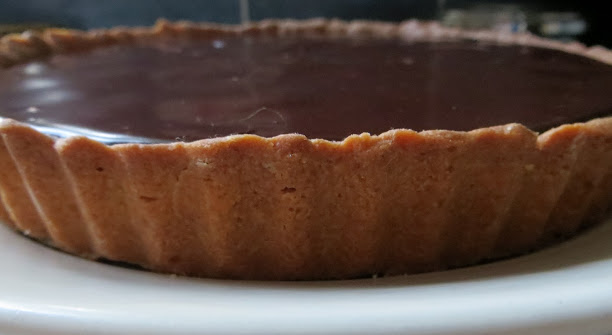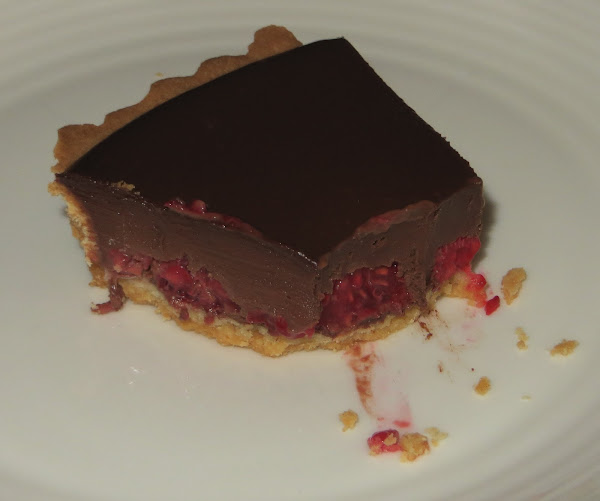
Following hot on the heels of recipe number three from the Michel Roux Desserts book comes recipe number four – a gorgeous looking chocolate and raspberry tart. With my paté sablée already chilled in the fridge for a good hour I was finally ready to move on to the tart proper.
First of all I had to roll out my pastry to approximately 3mm thick and use it to line my tart tin. Enter problem number one. If you’ve read my last post about making the paté sablée you’ll know that I had to add extra flour to get it to a rollable consistency. Once I started working with it however I wondered if I needed to add yet more – that pastry was just soooooo delicate. I could roll it but as soon as I tried to move it, it just fell apart. The chances of getting it into the tin without it not only ripping but darn near crumbling were exactly nil so I needed a new plan.

Rather than adding more flour and going through the chilling process again I decided to get a little creative. I wasn’t at all sure that adding extra flour would be the right thing to do anyway so instead I removed the base from my tart tin, laid it on the worktop and rolled the pastry directly on to it. Once the pastry was just over the edges I lifted the whole thing and dropped in back into the outer of the tin. Voila!

Well sort of anyway. I still had to faff around with the sides of the tin, pushing the pastry up the sides and trying to make it vaguely even. There will surely be no prizes for this technique but in my defence I did stop short of using a pepper pot as a mini rolling pin to work inside the tin. I absolutely guarantee the lid would have fallen off and the whole thing would have ended up in the bin if I had.
Once the paté sablée had been pressed into submission I had to bake it blind, finally my baking beans got an outing. I swear I bought these two years ago after having them on my wish list for about five years before that and they’ve never made it out of the tub before. Ridiculous. I need to make more tarts.

The rest of the tart came together easily with the raspberries being pressed on to the base of the pastry case before covering in the chocolate mixture and then chilled for at least two hours. I opted for 70% dark Lindt chocolate for this – a sort of compromise between the Valrhona that Michel Roux recommends (ouchy expensive) and the Sainsbury’s own dark chocolate I often use when I’m baking less intentionally impressive things if you see what I mean. (In fairness it’s much nicer tasting than you might expect, but the cocoa content is low.)

So was all that pastry faffing worth it? Oh yes, it most definitely was; this tart is absolutely divine. Not the most complicated thing to make pastry aside but my goodness the results make it seem as if you slaved for days. This is probably partly down to using good ingredients and it wasn’t cheap to do – I think I spent about £10 altogether using the Lindt and proper butter. There’s also one ingredient you might not have to hand quite so readily as you need liquid glucose. I happened to already have some and it’s not that hard to find.

I was actually hugely proud of the taste and texture of my pastry in the end. Somehow I managed to end up with a very crisp and even pastry case that tasted really good. Absolutely no hint of sogginess whatsoever and an impressive sound and crumbliness when I cut through it. Maybe my odd technique isn’t quite to be sniffed at after all.


The tart is quite rich with that dark chocolate and the sharpness of the raspberries is a wonderful, juicy refresher cutting through the richness. If you wanted to balance it even further you could serve with cream or ice cream but either way I found a small slice perfectly satisfying. I would definitely make this tart again for an occasion. It’s impressive to look at, impressive to taste and you can easily make it in advance of a dinner party. Another hit for me from this very impressive book.


No comments:
Post a Comment
Please enter your comment and then submit. We love to hear from you